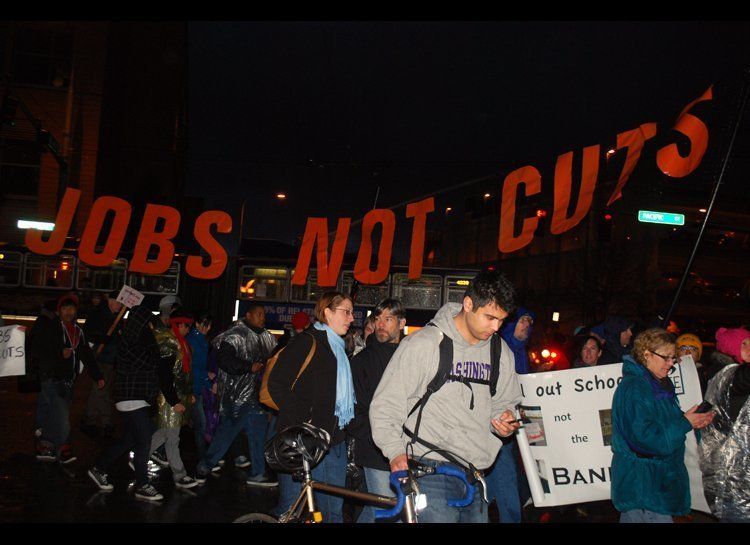Protesters with the Occupy Seattle movement joined in solidarity on November 17 with hundreds of university students, labor unions, clergymen, nurses, retirement organizations and more, to rally in support of education and jobs. The march occurred on multiple streets, with participants joining for a rally near Husky Stadium, then peacefully overtaking the University Bridge spanning Portage Bay. Traffic was closed in all directions for almost two hours, as activists chanted slogans such as "Money for jobs and education -- NOT for banks and corporations" and "This is what democracy looks like."
As local legislators have moved in recent days to make significant cuts in jobs, education and services, citizens across the city are calling for "jobs, not cuts", as evidenced by signs and banners waving in the wind and rain in a steady march across the bridge during rush-hour traffic. Young people climbed the towering bridge structure, leading the crowd in chants and slogans from above. The bridge was targeted for occupation in the November 17th march partly in support of initiatives by the Obama administration to create jobs by building infrastructures such as roads and bridges.
Representatives from local labor unions were out in full force, carrying signs proclaiming that "labor creates all wealth" and chanting their growing impatience with the apparent failure of government and private industry to recognize the connection between the everyday work force of America and it's prosperity. They signaled a growing reluctance by workers to continue accepting failed economic policies that directly affect the living standards of the largest portion of the country's population.
"No jobs - No peace" was the rally call for members of Teamster 117 in Seattle, asserting that "the union is under attack by today's political system." Marching for his job, Adam Hoyt says that, under recent proposed budget cuts in Washington state, his household income would be cut in half. His wife is a state employee at risk for job elimination.
Upon overtaking the bridge, some activists spread their bodies on the steel flooring grids spanning the structure, with the swirling waters of the bay visible beneath. Tamara Nielson, a longtime resident of Seattle, was an activist decades ago during the Vietnam War. Nielson admits that she's been wanting to make a stand for change ever since the first Bush administration, but allowed complacency to deter her. "We forget," she says wistfully, "but it's time as Americans to wake up again."
Members of the clergy have been active in the Occupy Seattle movement, both at Westlake Park, City Hall and the long-term camp at Seattle Central Community College. Meredith Dodd, a minister at Greenlake Methodist Church in Seattle, marched across University Bridge on November 17, dressed in a flowing white cleric's robe and holding a banner that hangs daily in the "Occupy Sanctuary" tent at the college.
"When nobody else cares for the sick, the poor and the vulnerable, I believe that God is there," says Dodd, "and that's why I'm here today."
As a testament to the far-reaching effects of the Occupy Seattle movement, the daily religious presence at the sanctuary tent includes ministers, rabbis, priests, yoga practitioners and more. When police unleashed pepper spray during earlier protest marches in November, those indiscriminately sprayed included peaceful members of the clergy wearing identifiable religious clothing.
To many participating in the rally, marches and occupation of University Bridge on November 17, an obvious solution to political and economic disparities, as well as to the enduring unemployment rate in America, is to utilize the country's workforce while "paying it forward" by investing in strong infrastructure and educated young people.
An oversized replica of the preamble to the United States Constitution was carried throughout Seattle streets and across the bridge on Thursday, reminding "we the people" of the founding fathers intent to "establish justice" and "promote the general welfare" of all citizens.
As the march on November 17 came to a close, the massive banner was finally lowered to the ground. Nearby, medics of the Occupy Seattle team stood by, thankful that their makeshift triage kit lay untouched atop the autumn leaves at the foot of University Bridge. Police presence was subdued in light of the earlier events of November 2 and 15, when the Seattle Police Department unleashed pepper spray on students, the elderly, medics, the media, clerics and passive legal observers.
Advertisement
